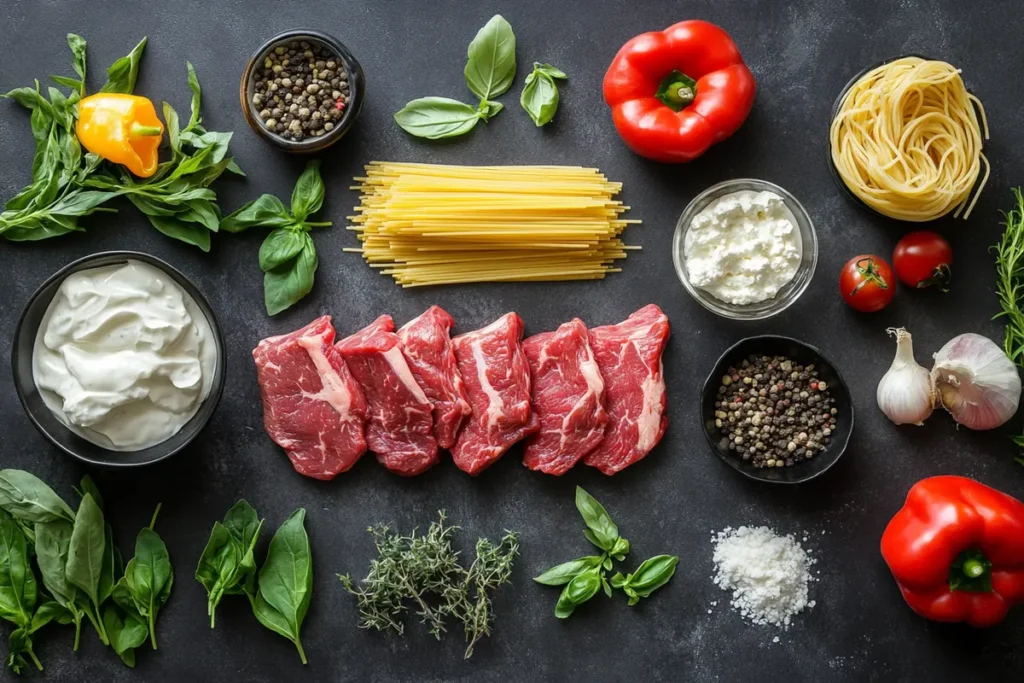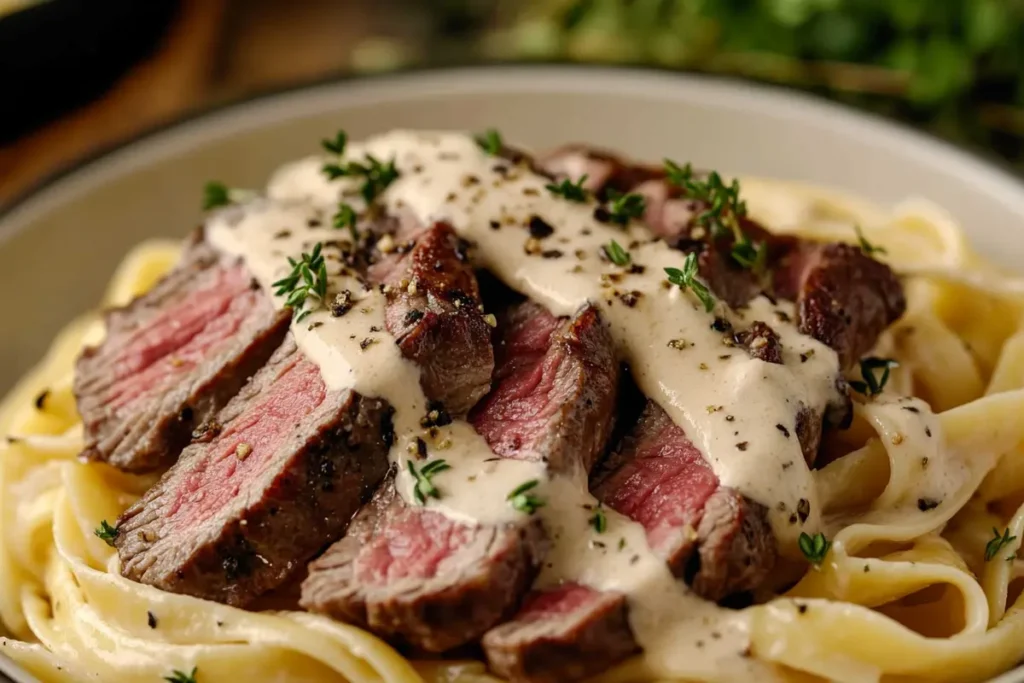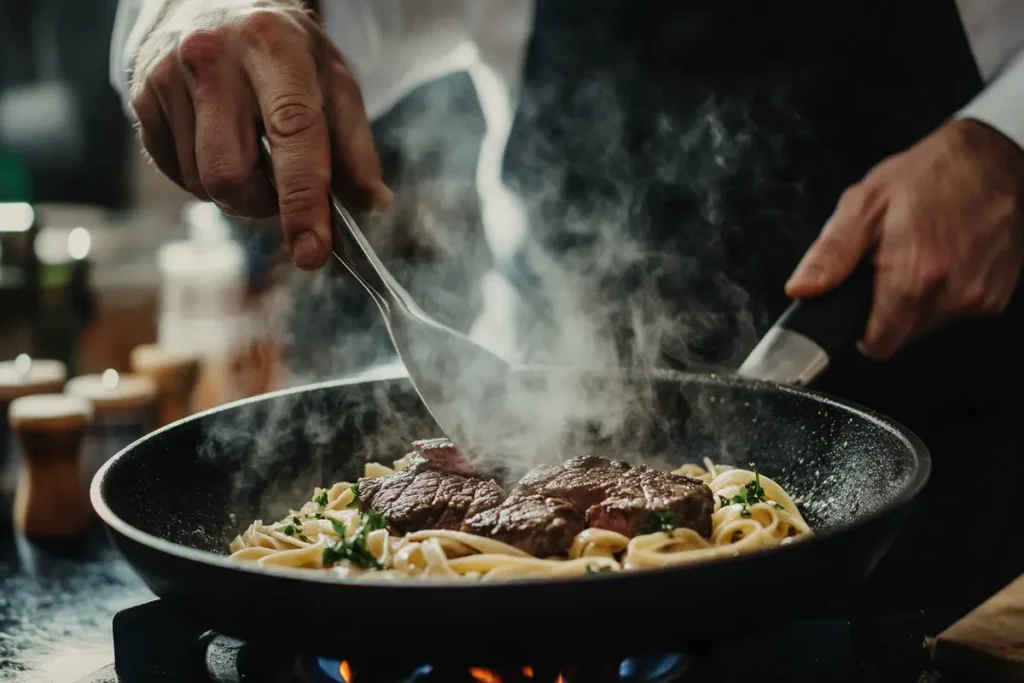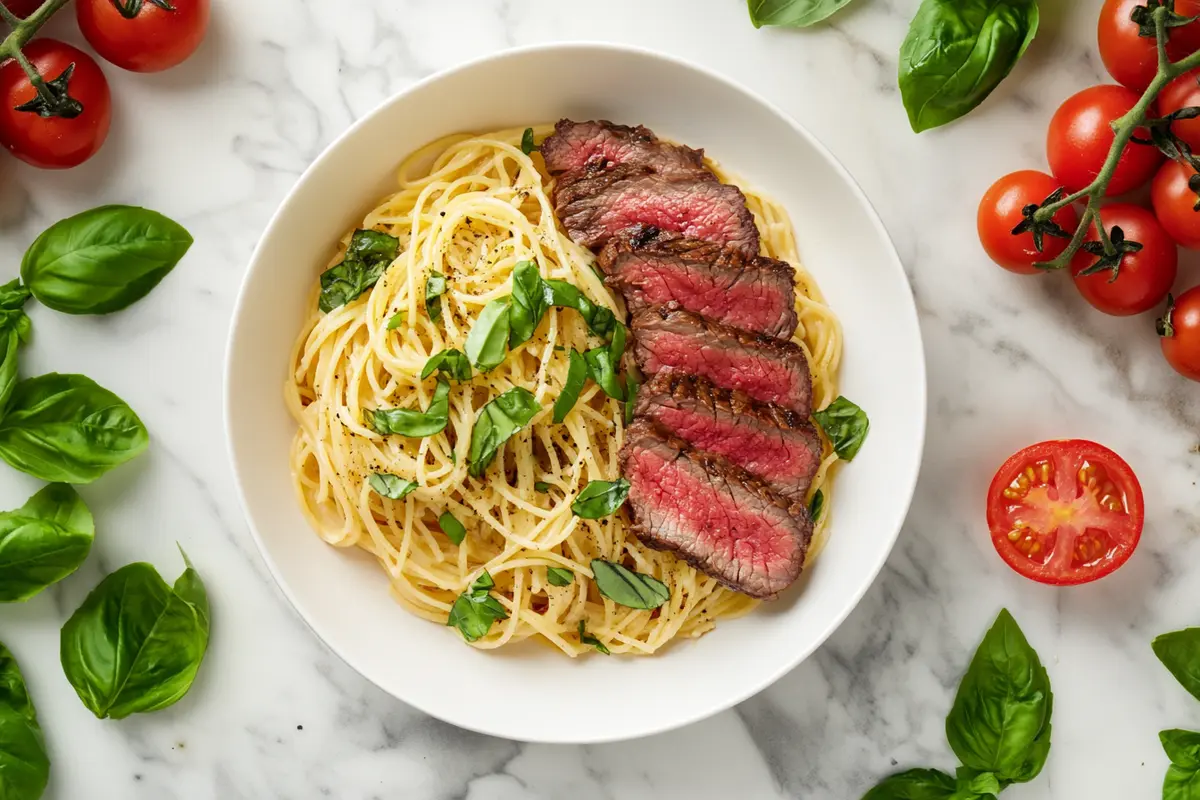Table of Contents
Steak pasta offers a delightful fusion of flavors and textures. This article will guide you through creating a naturally perfect dish. It’s both satisfying and impressive, a meal that is sure to please everyone.
Discover the Appeal of This Hearty Pasta Dish
The combination of tender steak with comforting pasta creates a naturally pleasing meal. It’s suitable for both casual weeknights and special occasions. You’ll find that making this dish is more straightforward than you might imagine. Furthermore, its adaptable nature lets you make numerous changes. Moreover, different steak cuts can be used based on your preferences. The unique fusion of flavors and textures ensures a memorable dining experience. This combination provides a balanced and fulfilling meal that’s easy to personalize.

Selecting the Best Steak for Your Pasta Creation
The choice of steak significantly affects the overall taste. Opt for tender cuts for the best results when preparing this pasta meal. Sirloin or ribeye, for instance, are excellent choices. They cook rapidly, seamlessly integrating into the dish. Marbling is also crucial, as it enhances flavor and maintains juiciness. Choose cuts with good marbling. Moreover, aim for a steak thickness of at least one inch for optimal results. This thickness ensures the steak stays moist during cooking and sears well. Also, consider the flavor profile of each cut; some are more robust than others. Select a cut that you enjoy and that will complement the other ingredients.
Preparing Your Steak for Enhanced Flavor
Before cooking, it’s important to let your steak reach room temperature for even cooking. This prevents the exterior from overcooking while the center stays cold. Pat the steak dry using paper towels to ensure a proper sear. Surface moisture will hinder the Maillard reaction which is key for a nice crust. Season generously with salt and freshly ground black pepper. Garlic and onion powder can also be added. These additions enhance the flavor of your steak for this pasta meal. Often, simple seasonings bring out the natural flavors best.
Cooking Your Steak to Perfection for Your Pasta
Heat a skillet over high heat, ensuring it’s very hot for the best sear. Add a high smoke point oil, such as grapeseed, to prevent burning. Sear the steak on all sides for a few minutes to create a beautiful crust. The crust enhances both flavor and texture. After searing, lower the heat and cook the steak to your preferred doneness. Use a meat thermometer for precise results. Let the steak rest for 5-10 minutes before slicing so the juices can redistribute. This leads to a more tender and juicy result, ideal for serving with pasta.
Choosing the Ideal Pasta for Your Steak Dish
The type of pasta you use can change the overall feel of the dish. Long, thin pasta like spaghetti or linguine work wonderfully, as they coat evenly with the sauce. Their shape allows for efficient sauce adherence. You can also use penne or rigatoni. These shorter pasta shapes hold sauce exceptionally well. These create a more substantial and satisfying meal. The texture of the pasta should complement the other elements of the meal, specifically the steak. Choosing the right pasta improves the overall dining experience.
Cooking Your Pasta the Right Way for Your Steak
Cook the pasta according to the package directions. It should be al dente, which means firm to the bite, not overcooked which could make it mushy when added to your sauce. Overcooked pasta will compromise the dish’s texture. After cooking, save some of the pasta water. This starchy water is excellent for creating a smoother sauce. The starch in the water acts as a natural emulsifier, helping the sauce to bind together and creating a more luxurious texture when combined with steak.

Crafting the Perfect Sauce for Your Steak Pasta
The sauce is key to the overall experience. A simple sauce of olive oil, garlic, and tomatoes works beautifully, offering a fresh, classic taste. Moreover, you can incorporate herbs such as basil or oregano for enhanced flavor. A dash of red pepper flakes will add some heat. However, you can also opt for a creamy sauce. A cream-based sauce will naturally complement the steak, adding richness and depth to the flavors of your pasta. There’s a broad range of flavors you can experiment with, tailoring the sauce to your preferences.
Combining the Elements of Your Pasta with Steak
Once your sauce is ready, add the sliced steak. Gently toss it with the sauce. Ensure that the steak heats thoroughly without overcooking it which can cause it to dry out. Then, add your cooked pasta. Toss everything together until the pasta is well coated, ensuring the sauce adheres uniformly. If the sauce is too thick, add a bit of the reserved pasta water. This will help create a smoother, more luxurious consistency, while adding a subtle flavor to your steak pasta.
Seasoning and Final Touches for Flavorful Results
Taste and adjust the seasonings as needed, always tasting before serving to guarantee it’s perfect. A squeeze of fresh lemon juice can brighten the overall flavors. Finally, garnish the dish with fresh parsley or grated Parmesan cheese. These additions refine both the presentation and the taste. Serve it immediately for the best experience. Fresh garnishes not only taste good but also add freshness to the dish.
Variations and Customizations for Your Steak Pasta
This steak pasta dish is easily customized to fit any preferences. For instance, you might add vegetables like mushrooms or bell peppers. They can add both texture and flavor. Sautéed onions also pair well with steak, adding sweetness and depth. Try experimenting with different cheese types. Mozzarella or provolone make the dish richer and more indulgent. Furthermore, different herbs like thyme or rosemary can add unique nuances to the sauce, adding earthy notes. Experimenting with these options will naturally broaden your understanding of the dish and enhance its appeal. The customization possibilities are endless, making it truly unique.
Different Steak Cuts for Various Tastes
For a different flavor profile, consider flank steak or skirt steak in your pasta. These flavorful cuts work well when thinly sliced. Remember though that flank and skirt steak can become tough if they are overcooked. Cook them to the correct level of doneness. Using a meat thermometer can help. Furthermore, try marinating your steak before cooking. This will infuse it with even more flavor. Marinades can also help tenderize the steak, making your pasta dish even more delightful.
Exploring Different Sauces for a Unique Experience
If a tomato-based sauce isn’t your preference, a creamy Alfredo sauce is another option. Use heavy cream, butter, and Parmesan cheese, plus a bit of garlic and nutmeg. This will provide a rich and decadent flavor to your pasta meal. This sauce is a classic Italian complement to pasta. Pesto sauce is another excellent choice, adding fresh and herbaceous flavors. These different sauce types offer a range of flavors, ensuring something for everyone’s taste.
Vegetarian Adaptations for Your Pasta
You can create a vegetarian version of this dish by replacing steak with mushrooms. Sliced portobello mushrooms or a mix of wild mushrooms adds a meaty texture. You can also include eggplant or zucchini, which provide a similar mouthfeel to steak. This ensures everyone can enjoy a version of the meal, even without meat. The goal is to create a dish that is satisfying and tasty regardless of dietary preferences.

Essential Tips for the Best Steak Pasta Results
Follow these crucial tips for the best outcome. First, use only high-quality, fresh ingredients. This will have a significant impact on your dish’s flavor. Second, don’t overcrowd the pan when searing the steak, as this hinders browning. Overcrowding the pan will cause the steak to steam rather than sear, which is undesirable. Third, let the steak rest after cooking to redistribute the juices, resulting in a more tender steak. Fourth, ensure the pasta is al dente—firm, not overcooked. Finally, season generously, tasting as you cook to adjust the seasonings appropriately. Following these steps will greatly improve the final results of your steak pasta.
The Importance of Fresh Herbs in Your Steak Pasta
Using fresh herbs makes a big difference, adding a depth of flavor that dried herbs cannot match. Use fresh basil, parsley, or oregano, adding them at the end to preserve their taste and fragrance. Fresh herbs enhance the taste and aroma of your steak pasta. A sprinkle of fresh herbs elevates the flavor profile and enhances the visual appeal of the dish.
Serving Suggestions for Your Delicious Pasta and Steak Dish
Serve your dish immediately after you prepare it so it tastes its best. Pair it with a crisp salad and some crusty bread to round out the meal and add complementary textures. The salad can give a refreshing contrast. A light-bodied red wine is a perfect accompaniment to your pasta and steak creation. It will complement the flavors. Your wine choice should enhance the dish’s flavors without overpowering them.
Making This Pasta Dish in Advance
If you need to prepare this dish ahead of time, consider cooking the sauce and pasta separately. Then, store them in the fridge. This prevents the pasta from becoming soggy. When you are ready to serve, reheat the sauce, cook the pasta, and then add the steak. This approach helps you maintain the dish’s quality when making it in advance. However, freshly cooked is always better as the flavors and textures are at their peak.
The Natural Allure of Steak Pasta
Ultimately, this is a naturally alluring dish that combines simple, high-quality ingredients. It’s a flexible and versatile recipe that’s easy to modify, perfect for any night. The pairing of hearty steak and comforting pasta is very satisfying. This is a dish that will be pleasing to everyone. It’s a meal that is sure to be enjoyed by all.
Conclusion
In summary, this steak pasta is a wonderful and straightforward option that impresses with both its taste and ease. By choosing quality steak and selecting the right pasta, you can easily create a very delicious meal. Using the tips and variations in this guide, your dish will be perfect for any occasion. Enjoy creating your unique version, enjoying the combination of steak and pasta.
Frequently Asked Questions (FAQs)
Do steak and pasta go together?
Yes, the pairing is excellent. The richness of steak complements the comforting nature of pasta. This combination creates a very satisfying meal, blending hearty and light elements. They naturally complement each other, creating a wonderful dining experience.
What is the best cut of steak for pasta?
Tender steak cuts such as sirloin, ribeye, or filet mignon are the best choices. These cuts cook quickly and stay tender, enhancing the experience. Flank and skirt steak work too, if sliced thinly. Consider marbling, as this adds to both flavor and moisture.
What does Gordon Ramsay cook his steak with?
Gordon Ramsay generally cooks his steak with salt, freshly ground black pepper, and a touch of olive oil, emphasizing high heat for searing. He also often adds herbs like thyme and garlic to elevate its flavor. Simple seasoning is often all you need for a high-quality steak.
What meat pairs well with pasta?
Several meats pair well with pasta. Besides steak, consider chicken, sausage, and shrimp. Ground beef and lamb are also great options. The key is to ensure that the meat’s flavors harmonize with the sauce and type of pasta used. Select a cut of meat that complements the entire dish.
For More Delicious Recipes :
Easy Mini Dessert Recipes for Any Occasion
What is Boom Boom Shrimp Made Of

